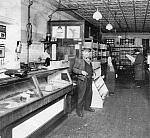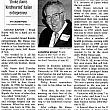
G.B. Russo Family History
by Kim Rush, John Russo, and Martin Starr
published: September 22nd, 2012
Traveling alone in 1900, an adventurous teen-age boy left his home, near Palermo in Sicily, the day after his fifteenth birthday, to make a new home in the United States. That young man, Giovanni Battista Russo, John Baptist in English, settled in Grand Rapids. With the help of his uncle, Antonio Lombardo Russo, an earlier arrival, G.B. secured a job shoveling coal into large stokers with his uncle’s employer, the Grand Rapids Gas Light Company. The job was physically exhausting and wages were low. But G.B. remained focused on saving money to bring his parents and three sisters to Grand Rapids as soon as he could afford it. His father, Francesco Russo, the first to be reunited with him, arrived at Ellis Island, March 17, 1904. Francesco joined his son and brother at the Grand Rapids Gas Light Company. Two years later, on May 15, 1906, G.B.’s mother, Girolama Lombardo, and his three sisters arrived at Ellis Island. By that time G.B. had opened a grocery business on South Division near Fifth (Franklin St.) that catered to fellow Italian immigrants. (Find more information to your right in Related Items)
G.B.’s grocery businesses carried such culinary staples as bulk olive oil, green and black olives, tomato paste, cheeses, pepperoni and salami, macaroni, bread, and baccala (dehydrated salted cod fish), which were made available through importers or local sources. Many of the early Italian immigrants were men who had temporarily left their families behind. (continue reading)
G.B.’s mother had Crucifissa Rocca meet with her daughters at a seamstress’ home. G.B. and a friend proceeded to "kidnap" Crucifissa to Holland where they were married. Kidnapping girls in those days was not uncommon because Italian girls were so scarce in America. The prospective bride’s parents, who did not consent to her marriage before the kidnapping took place, then demanded . . . continue reading
Deputy state food inspector William Mickle visited G.B.’s store and macaroni factory less than a month after his wife’s death in early 1913. He found cats and a horse in the same building where Russo was making macaroni. When Mickle returned to further investigate in December, he was still not satisfied with the sanitary conditions in the factory. To make it even more embarrassing for G.B., results of the inspection were published in the Grand Rapids Press. continue reading
A friend told G.B. that he knew of a nineteen-year-old woman in Pittsburgh that would be good wife for him. G.B. traveled immediately to Pittsburgh, was introduced to her, and they were soon married. Approximately sixteen months after Crocifissa’s death, Russo married ‘Jennie’ (Giovanna Menzalora) in Pittsburgh, Pennsylvania on June 25, 1914. Though they were deeply in love . . . continue reading
Black Hand members attempted to kidnap Josephine Russo, G.B.’s eighteen-month-old daughter, in front of the Home Bakery at 643 South Division Avenue in September 1914. Her nurse bravely warded off the attackers and prevented anyone from harming the child. Russo family members explain that there was jealousy exhibited toward members of this early Italian community . . . continue reading
G.B. helped his mother-in-law, Concetta Amante, sell groceries out of her home on Sheldon SE, located just a few blocks from his store, while Concetta’s husband, Joseph (Giuseppi) Amante was serving in World War I. G.B. set up a grocery store in Concetta's living room to help support Concetta and her children. continue reading
G.B Russo, a gracious friend to many, assisted the powerful and the downtrodden as well as those that fell in between. He was a friend of George Welsh, one of Grand Rapid’s most powerful politicians. Initially, Welsh figured that Russo might help procure voters from the Italian community. Welsh also shopped regularly at G.B.s store. G.B. was also a friend of Frank Lamar, a kingpin of Grand Rapids’ African-American community from the 1930s (continue reading)
Frank Russo had a nervous breakdown during the 1967 riots and never really recovered. His son John recalls, “The shock of the riots was too much for him to take. My mom and I had to take over most of the decision-making as he relied on us to take care of the business. I was 18. Dad also suffered a series of strokes that slowed him down. My dad always said, ‘I was born in that building and will die there.’ " (continue reading)
It was late on Sunday evening, August 11, 1991, when a spokesperson for the Grand Rapids Police Department notified cousins John and Frank G. Russo that the roof had collapsed over a cluster of buildings and apartments that they owned. A windstorm had buckled its weakened roof and the front of the building was beginning to topple, as well. continue reading
Bibliography
Items Available at the History & Special Collections Dept., Grand Rapids Public Library
- Carmack, Sharon DeBartolo. Italian-American Family History: a guide to researching and writing about your heritage. Genealogical Pub. Co., 1997
- Italian-American Information Clipping Files
- Noto, Scott. Escaping La Miseria: the Story of Grand Rapids First Italian Residents. Grand River Valley History, Vol. XVI, 1999.
Books Available for Circulation at the Grand Rapids Public Library
- Adams, Suzanne Russo. Finding Your Italian Ancestors: a beginner’s guide. Ancestry Pub., 2008.
- Iorizzo, Luciano J., Mondello, Salvatore. The Italian Americans. G.K. Hall, 1980.
- Marinacci, Barbara. They Came From Italy: the stories of famous Italian-Americans. Dodd, Mead, 1967
- Papaleo, Joseph. Italian Stories. Dalkey Archive Press, 2002.
- A Subject search of the library's catalog for Italian-Americans will find many more books about this subject.










 facebook
facebook











